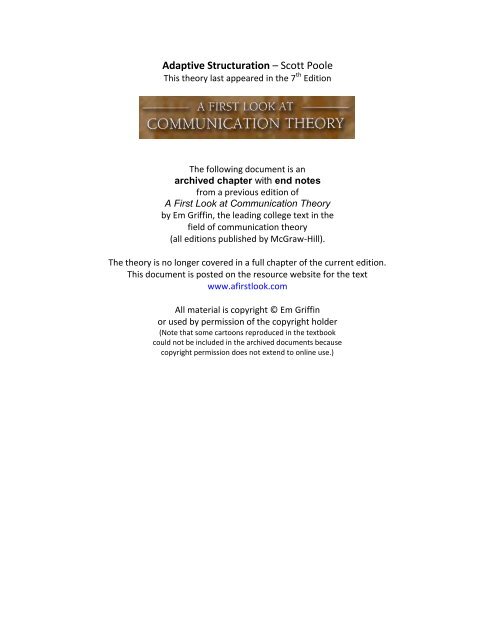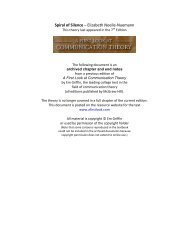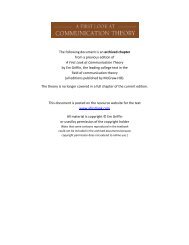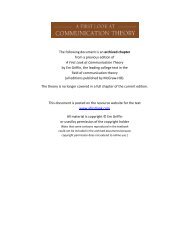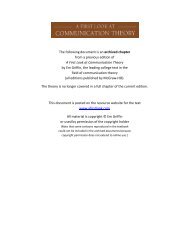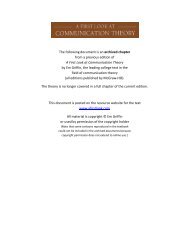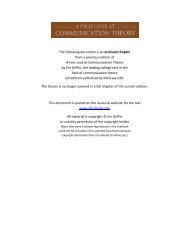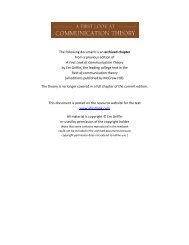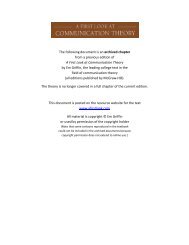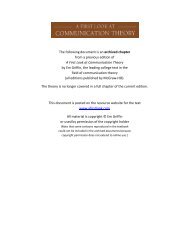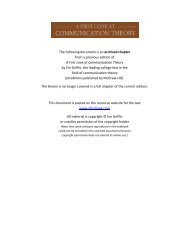Adaptive Structuration Theory of Marshall Scott Poole
Adaptive Structuration Theory of Marshall Scott Poole
Adaptive Structuration Theory of Marshall Scott Poole
Create successful ePaper yourself
Turn your PDF publications into a flip-book with our unique Google optimized e-Paper software.
<strong>Adaptive</strong> <strong>Structuration</strong> – <strong>Scott</strong> <strong>Poole</strong><br />
This theory last appeared in the 7 th Edition<br />
The following document is an<br />
archived chapter with end notes<br />
from a previous edition <strong>of</strong><br />
A First Look at Communication <strong>Theory</strong><br />
by Em Griffin, the leading college text in the<br />
field <strong>of</strong> communication theory<br />
(all editions published by McGraw-Hill).<br />
The theory is no longer covered in a full chapter <strong>of</strong> the current edition.<br />
This document is posted on the resource website for the text<br />
www.afirstlook.com<br />
All material is copyright © Em Griffin<br />
or used by permission <strong>of</strong> the copyright holder<br />
(Note that some cartoons reproduced in the textbook<br />
could not be included in the archived documents because<br />
copyright permission does not extend to online use.)
CHAPTER 18<br />
Socio-cultural tradition<br />
Cybernetic tradition<br />
<strong>Adaptive</strong> <strong>Structuration</strong><br />
<strong>Theory</strong><br />
<strong>of</strong> <strong>Marshall</strong> <strong>Scott</strong> <strong>Poole</strong><br />
Imagine that you are a third-year communication major who signed up late for<br />
a required course in communication theory. Since you missed the first class and<br />
haven't seen the syllabus, you aren't sure what to expect. When you walk into<br />
the room, you're surprised to find out that there are only 12 students in the class,<br />
no course syllabus, and no instructor present. When the other students start to<br />
talk about tests and papers, the scope <strong>of</strong> assignments, and the breadth and depth<br />
<strong>of</strong> coverage, the guy sitting next to you fills you in. The pr<strong>of</strong> has made this an<br />
experimental section and has given students the responsibility to structure the<br />
course before he returns to class.<br />
In the discussion that follows it becomes apparent that there are at least a<br />
few parameters or rules. The class will meet from noon till 2 P.M. every Tuesday<br />
and Thursday for the entire term. The instructor has adopted a text that introduces<br />
over 30 communication theories, and he will be there from the third week<br />
on to serve as a resource. No matter how final grades are assigned, they should<br />
reflect what individuals have really learned- nobody gets an automatic A. Other<br />
than those givens, class members have two weeks to decide which theories to<br />
cover, how to use the scheduled class time, what course projects to assign, and<br />
how students should be evaluated. Essentially, the group is free to shape the course<br />
any way it wants.<br />
After an hour, you seriously consider dropping the course. Josh, the pr<strong>of</strong>'s<br />
teaching assistant, and Paige, a sophomore transfer student, are totally monopolizing<br />
the discussion. Everything Josh is for, Paige is against, and vice versa.<br />
Michelle's only contribution is to insist that she doesn't want to take part in a<br />
group project. Mike, a varsity linebacker, and Karla, a campus beauty, chat about<br />
plans for Saturday night while ignoring the rest <strong>of</strong> the discussion. A few other<br />
students <strong>of</strong>fer tentative suggestions, but Megan looks confused and Pete puts his<br />
head on the desk and snoozes.<br />
You decide to stick it out but ask yourself, Will the group stay this way for the<br />
entire semester, or will it change? You worry that this specific mix <strong>of</strong> individual<br />
motivations and personalities makes more <strong>of</strong> the same a foregone conclusion.<br />
235
236 GROUP AND PUBLIC COMMUNICATION<br />
PHASING OUT THE PHASE MODEL<br />
And even though the pr<strong>of</strong> has labeled the class format "experimental," you also<br />
wonder, Are we really free to create whatever we want or are the results inevitable,<br />
given the academic setting?<br />
The first question raises the issue <strong>of</strong> group stability versus group change. The<br />
second question revisits the dilemma presented in Chapter I- members' freely<br />
chosen actions versus their behavior determined by existing social structures.<br />
These are the two group-related questions that University <strong>of</strong> Illinois communication<br />
pr<strong>of</strong>essor <strong>Scott</strong> <strong>Poole</strong> seeks to answer with adaptive structuration theory.<br />
When asked to state the core idea <strong>of</strong> his theory, <strong>Poole</strong> <strong>of</strong>fers this synopsis:<br />
Members in groups are creating the group as they act within it. ... A lot <strong>of</strong> times<br />
people in groups build up structures or arrangements that are very uncomfortable<br />
for them, but they don't realize that they're doing it. The point <strong>of</strong> structuration<br />
theory is to make them aware <strong>of</strong> the rules and resources that they're using so that<br />
they can have more control over what they do in groupS.1<br />
The implication <strong>of</strong> <strong>Poole</strong>'s claim is that you and other class members are just<br />
as responsible for Josh and Paige's domination <strong>of</strong> class discussion as they are.<br />
Will things change? Only if you and the others make it happen. Are all <strong>of</strong> you<br />
free to change the way you're reacting? Only to the extent that you are aware <strong>of</strong><br />
what you're doing.<br />
At first glance these answers may seem simplistic. But they are derived from<br />
an understanding <strong>of</strong> structuration, a concept that is quite sophisticated. <strong>Poole</strong><br />
adopted the idea only after a decade <strong>of</strong> empirical research convinced him that<br />
no single model <strong>of</strong> group development adequately explains what takes place in<br />
decision-making groups. Let's see what he found.<br />
For much <strong>of</strong> the twentieth century, small-group researchers thought they had<br />
spotted a universal pattern <strong>of</strong> communication that all groups use when they<br />
make a decision. These scholars generally agreed that there was a good fit<br />
between the following single-sequence model and the actual phases that groups<br />
go through as the members reach agreement: 2<br />
Orientation-efforts are unfocused because group goals are unclear; relationships<br />
are uncertain; members need more information.<br />
Conflict- factions disagree on how to approach the problem and argue<br />
against other viewpoints; members justify their own positions.<br />
Coalescence-tensions are reduced through peaceful negotiation; members<br />
allow others to "save face" by adopting solutions acceptable to all.<br />
Development-the group concentrates on ways to implement a single solution;<br />
members are involved and excited.<br />
Integration-the group focuses on tension-free solidarity rather than the<br />
task; members reward each other for cohesive efforts.<br />
If the phase model is right, your communication theory group is now in the<br />
conflict stage, but it will sooner or later shift to a more cooperative pattern.<br />
Despite widespread acceptance <strong>of</strong> this one-size-fits-all phase model <strong>of</strong> group<br />
decision making, <strong>Poole</strong> wasn't convinced. Beginning with his dissertation research
Social structures<br />
Rules and resources <strong>of</strong> a<br />
group; characteristics<br />
such as composition,<br />
norms, communication<br />
networks, status hierarchies,<br />
task requirements,<br />
and peer pressure.<br />
CHA PTER 18: ADAPTIVE STRUCTURATION THEORY<br />
237<br />
in 1980 and extending throughout that decade, he sought to find out if and when<br />
ongoing groups actually conform to the single-sequence model when making<br />
tough decisions on important issues. <strong>Poole</strong> tracked 47 specific decisions made by<br />
29 different groups in natural settings- real people making real decisions. 3<br />
Early in his research, <strong>Poole</strong> discovered that only a quarter <strong>of</strong> the groups actually<br />
followed the discussion pattern laid out in the single-sequence model. But just as<br />
Hirokawa and Gouran <strong>of</strong>fer their functional perspective as a preferred procedure<br />
for task groups to adopt (see Chapter 17), <strong>Poole</strong> was still hopeful that the five phases<br />
<strong>of</strong>fered a blueprint for reaching high-quality decisions. He wrote that "the unitary<br />
sequence provides a logically ideal format for decision making and it may well be<br />
the simplest effective path a decision-making group could follow.,,4<br />
Yet the longer <strong>Poole</strong> examined the complexity <strong>of</strong> group decision making, the<br />
less optimistic he became that any theory or model would be able to predict a<br />
specific sequence <strong>of</strong> action. By the end <strong>of</strong> the decade, he was disenchanted with<br />
the scientific quest to discover a fixed pattern <strong>of</strong> group behavior. He became<br />
convinced that group dynamics are far too complicated to be reduced to a few<br />
propositions or a predictable chain <strong>of</strong> events. He also grew uncomfortable with<br />
the phase model's objectivist assumption that group and task structures dictate<br />
the way a decision is made. In effect, the model claims that communication has<br />
no significant impact on the process or the outcome; group members are just<br />
along for a five-stage ride.<br />
<strong>Poole</strong> continued to think that group members are affected by social structures<br />
such as group composition, communication networks, status hierarchies, task<br />
requirements, group norms, and peer pressure. But he no longer saw these structures<br />
as determining how the group reached a decision or what that decision<br />
might be. He was convinced that what people say and do makes a difference.<br />
Given this commitment, <strong>Poole</strong> and two other communication scholars, Robert<br />
McPhee (Arizona State University) and David Seibold (University <strong>of</strong> California,<br />
Santa Barbara), became intrigued by the work <strong>of</strong> British sociologist Anthony<br />
Giddens. Giddens suggests that people in society are active agents in the sense<br />
that they are "able to act otherwise" and have the capacity "to make a difference."s<br />
McPhee went on to apply Giddens' core ideas in an organizational context,<br />
while Seibold used them to analyze the structure <strong>of</strong> arguments. But in<br />
Giddens' macrotheory <strong>of</strong> societal structuration, <strong>Poole</strong> saw insights that could be<br />
adapted and applied to the microlevel <strong>of</strong> small-group activity.<br />
STRUCTURATION ACCORDING TO GIDDENS<br />
<strong>Structuration</strong><br />
The production and reproduction<br />
<strong>of</strong> socia I systems<br />
through group<br />
members' use <strong>of</strong> rules and<br />
resources in interaction.<br />
Currently the director <strong>of</strong> the London School <strong>of</strong> Economics, Anthony Giddens was<br />
the chief intellectual adviser to former British prime minister Tony Blair. Colleagues<br />
call him "the most important English social philosopher <strong>of</strong> our time.,,6 Giddens<br />
openly admits that structuration "is an unlovely term at best,,,7 yet he believes that<br />
no other word adequately captures the process <strong>of</strong> social structures shaping peopie's<br />
actions while at the same time being shaped by their actions. Specifically, st<br />
ructuration refers to "the production and reproduction <strong>of</strong> the social systems<br />
through members' use <strong>of</strong> rules and resources in interaction."s<br />
By using the word interaction, as opposed to the more passive term behavior,<br />
Giddens signals his belief that people are relatively free to act as they will. They<br />
aren't merely pawns in the game <strong>of</strong> life or unsuspecting dupes controlled by<br />
unseen forces they can't resist. He says that every social actor knows a lot about
238 GROUP AND PUBLIC COMMUNfCATfON<br />
the way society works, and when asked, these competent social agents can<br />
explain most <strong>of</strong> what they do. 9<br />
Giddens uses the phrase rules and resources interchangeably with the term<br />
structures. Rules are implicit formulas for action, recipes for how to "get on" in<br />
life.lO They are guides for participants on how to play the game. Resources refers<br />
to all the relevant personal traits, abilities, knowledge, and possessions people<br />
bring to an interaction. Resources are almost always in short supply and tend to<br />
be unequally distributed within a society. Because rules and resources (structures)<br />
are constantly changing, structuration is a fluid process.<br />
Production <strong>of</strong> social systems is a process akin to the "creation <strong>of</strong> social realities"<br />
in CMM (see Chapter 6), although Giddens refers to sweeping changes across<br />
an entire society, not just among persons-in-conversation. Production happens<br />
when people use rules and resources in interaction. So does reproduction. Reproduction<br />
occurs whenever actions reinforce features <strong>of</strong> systems already in place,<br />
and thus maintain the status quo.<br />
<strong>Poole</strong> applies and extends these key concepts <strong>of</strong> structuration within small<br />
groups, but a brief example <strong>of</strong> societal structuration may help you picture the kind<br />
<strong>of</strong> large-scale process that Giddens imagines. The sexual revolution that began in<br />
the 1960s illustrates how the widespread adoption <strong>of</strong> new rules and resources dramatically<br />
transformed patterns <strong>of</strong> physical intimacy. Through faithful use (a rule)<br />
<strong>of</strong> "the Pill" (a resource) prior to sexual intercourse (an interaction), women increased<br />
their control over their own bodies (production). The change in contraception meant<br />
that men worried less about unwanted pregnancy, thus reinforcing (nonbiological<br />
reproduction) the sexual double standard that it is men's role to push for greater<br />
sexual intimacy and women's responsibility to say when to stop (a rule).<br />
Giddens' concept <strong>of</strong> structuration is the core idea that spawned adaptive structuration<br />
theory. <strong>Poole</strong> calls his theory adaptive structuration because he observes<br />
members <strong>of</strong> task groups intentionally adapting rules and resources in order to<br />
accomplish their decision-making goals. His "adaptive" label also seems appropriate<br />
because, along with his then University <strong>of</strong> Minnesota colleague Gerry DeSanctis,<br />
he's tailored Giddens' macrosociological principles to the microworld <strong>of</strong> small<br />
groups. When applied to group interaction, structuration obviously describes a<br />
process more intricate than the five-phase model presented earlier in the chapter.<br />
That's fine with <strong>Poole</strong>. He believes that the "value <strong>of</strong> a theory <strong>of</strong> group decision<br />
making hinges on how well it addresses the complexities <strong>of</strong> interaction." 11<br />
In the rest <strong>of</strong> the chapter I'll continue to use the example <strong>of</strong> an experimental<br />
communication theory course to illustrate key elements <strong>of</strong> adaptive structuration<br />
theory. Although this example is hypothetical, every part <strong>of</strong> the case study is<br />
drawn from actual class experience. Since <strong>Poole</strong> recommends ethnography as one<br />
<strong>of</strong> the ways to explore structuration, I'll write you into the picture and ask you<br />
to think <strong>of</strong> yourself as a participant observer in the events that I describeY I'll<br />
follow the same interaction, rules and resources, production and reproduction order<br />
that I used to parse Giddens' concept <strong>of</strong> structuration.<br />
INTERACTION: CONCERNS O F MORALITY, COMMUNICATION, AND POWER<br />
Group structuration is the result <strong>of</strong> action, and so whenever members interact,<br />
they have an impact on the group. If the rules and resources <strong>of</strong> the group change,<br />
it's because members do something that changes them. But <strong>Poole</strong> makes it clear
Interaction<br />
Intentional acts <strong>of</strong> group<br />
members who are aware<br />
<strong>of</strong> what they are doing.<br />
CHAPTER 18: ADAPTIVE STRUCTURATlON THEORY<br />
239<br />
that action doesn't always alter rules and resources. "If the structure <strong>of</strong> the group<br />
stays the same, it is because members are acting in such a way that the same<br />
structure is created and maintained with every act."l3 That seems to describe the<br />
entire two hours <strong>of</strong> the first class you attended.<br />
The next class is different. Right from the start, class members interact with<br />
each other on how to design the course. Even Pete wakes up to the realization<br />
that he has a stake in what's decided and voices a depth-over-breadth rationale<br />
for concentrating on fewer theories-perhaps only a dozen. Michelle piggybacks<br />
on his idea, suggesting that each student become an expert on a different theory.<br />
Andrew w elcomes the chance to specialize in one area-on the condition that he<br />
can pick a theory <strong>of</strong> new media that will intersect with his double major <strong>of</strong> communication<br />
and computer science. This surge <strong>of</strong> interaction supports <strong>Poole</strong>'s optimistic<br />
assumption that group members are "skilled and knowledgeable actors<br />
who reflexively monitor their activities as they navigate a continuous flow <strong>of</strong><br />
intentionality."14<br />
Skilled and knowledgeable actors don't always agree, however. Paige<br />
expresses concern that people will select only theories that are familiar or within<br />
their comfort zone. She thinks everyone should discuss theories that question<br />
unjust corporate control <strong>of</strong> the media and propose ways in which poor people<br />
could have a voice. Mike wants Pete to explain what he means by studying<br />
theory in depth. If he's referring to practical application, fine. If he means wading<br />
through primary sources, no way. Reminding the class <strong>of</strong> his special status as<br />
the pr<strong>of</strong>essor's TA, Josh claims that the pr<strong>of</strong> won't let the group concentrate on<br />
only a dozen theories while ignoring the other 20 that are in the book. Note that<br />
these class members raised issues <strong>of</strong> morality, communication, and power-issues<br />
that <strong>Poole</strong> and Giddens agree are fundamental in any social interaction. <strong>Poole</strong><br />
writes that these three elements are mixed together in every group action. He<br />
says that it's "hard to use moral norms without considering their interpretation-a<br />
matter <strong>of</strong> m eaning- and how they are 'made to count'-a matter <strong>of</strong><br />
power."lS<br />
Megan, always a sensitive observer <strong>of</strong> the human scene, notices that Lauren<br />
seems hesitant to speak. By specifically asking for her opinion, Megan tries to<br />
create a space for Lauren to be heard. In a s<strong>of</strong>t voice, Lauren wishes there could<br />
be a midrange compromise on the breadth/d epth issue. After class you overhear<br />
her thanking Megan for caring what she thinks. No doubt Megan's intentions<br />
were good, but in subsequent classes you observe that Lauren is even quieter.<br />
This confirms <strong>Poole</strong>'s structuration research, which suggests that advocacy can<br />
sometimes hurt rather than help a reticent member <strong>of</strong> the group.16 Megan's<br />
encouragement may simply reinforce Lauren's tendency to wait for an invitation<br />
before speaking up. Even actions that are well-thought-out have unanticipated<br />
consequences.<br />
The class experience I've described so far highlights two key points <strong>of</strong> adaptive<br />
structuration theory. First, communication in small task-groups makes a difference.<br />
We might know the structure <strong>of</strong> a group, the nature <strong>of</strong> its task, and even<br />
the history and personality <strong>of</strong> each member. But it is impossible to predict what<br />
decisions the group will make without hearing what's been said. Communication<br />
matters.<br />
Second, adaptive structuration theory has a "critical edge.,,17 Recall that<br />
critical theories strive to reveal unfair social practices and free people from<br />
oppressive systems (see Chapter 4). By highlighting the way in which undemocratic
240 GROUP AND PUBLIC COMMUNICATION<br />
group processes can be altered, <strong>Poole</strong> hopes to empower people who are now<br />
treated as second-class citizens.<br />
THE USE AND ABUSE OF RULES AND RESOURCES<br />
Rules<br />
Propositions that indicate<br />
how things ought to be<br />
done or what is good or<br />
bad; recipes for actions.<br />
Resources<br />
Materials, possessions, or<br />
attributes that can be<br />
used to i nfl uence or control<br />
the actions <strong>of</strong> the<br />
group or its members.<br />
Appropriation<br />
Adopting a rule or re <br />
source from another<br />
group or the larger<br />
cu lture.<br />
<strong>Poole</strong> refers to small-group rules as "prorsositions that indicate how something<br />
ought to be done or what is good or bad." 8 Although rarely put into words, these<br />
rules contain the collective practical wisdom that members have gleaned on how<br />
best to reach the group goal. The resources that individuals bring to the task are<br />
"materials, possessions, or attributes that can be used to influence or control the<br />
actions <strong>of</strong> the group or its members.,,19 As a research strategy, <strong>Poole</strong> selects a few<br />
structures that appear to be pivotal and then examines them in greater depth.<br />
Personal relationships quickly emerge as a resource for the class discussion.<br />
Megan and Lauren's growing friendship and Mike and Karla's romantic closeness<br />
seem to add impact to their words. You find that when any <strong>of</strong> them say<br />
something in class, you tend to assume that they speak for their partner as well.<br />
But it is Andrew who possesses the most effective relational resource. In contrast<br />
to the computer geek stereotype, he's a genuinely warm guy whom everyone<br />
likes. When the two <strong>of</strong> you took the same interpersonal course, he turned out to<br />
be the most competent face-to-face communicator in the class. When Andrew<br />
speaks, others listen, and vice versa.<br />
Topic expertise is <strong>of</strong>ten another key resource in group decision making.<br />
Although none <strong>of</strong> you have any training in education methods or curriculum<br />
development, some students start the course with more knowledge about communication<br />
theories than others do. Because he's performed months <strong>of</strong> library<br />
and Internet research for the instructor you've yet to meet, Josh has inside knowledge<br />
<strong>of</strong> the type <strong>of</strong> theory that this pr<strong>of</strong> would value. Josh presents these insights<br />
in a self-confident manner; thus, his insights carry more weight in the discussion.<br />
Status structures are almost always important in group structuration.<br />
Some <strong>of</strong> you know that Michelle carries a 4.0 GPA and is a member <strong>of</strong><br />
Lambda Pi Eta, the national communication honor society. She's a loner who<br />
doesn't say much in class, so you imagine that she must be impatient with the<br />
value the group places on relationships rather than intellectual resources. After<br />
all, she might reason, I'm in this class to learn communication theory, not to join a<br />
social club. Her likely frustration highlights <strong>Poole</strong>'s claim that group structures<br />
can constrain members from acting freely. And if Michelle doesn't bring her<br />
knowledge and intelligence to bear on designing the course, it ceases to be a<br />
resource for the group. Conversely, one who makes the effort to understand and<br />
use these structures-as Josh does-can become an effective player.<br />
A group's rules and resources are <strong>of</strong>ten borrowed from parent organizations<br />
or from the larger culture. <strong>Poole</strong> calls this process appropriation. Given that students<br />
in your class come from a variety <strong>of</strong> backgrounds and have experienced<br />
different leadership styles, <strong>Poole</strong> wouldn't be surprised if the rules you appropriate<br />
for making decisions don't square with standard parliamentary procedure.<br />
As it turns out, he anticipates how your class reaches a decision on the depth/<br />
breadth issue when he writes, "Different groups may appropriate the political<br />
norm <strong>of</strong> majority rule in a variety <strong>of</strong> ways. One group may regard the rule as a<br />
last resort, to be used only if consensus cannot be attained.. . . ,,20<br />
Consensus is the only decision path acceptable to most students in your<br />
group. You personally feel that way because it's a seminar type <strong>of</strong> course and you
CHAPTER 18: ADAPTIVE STRUCTURATION THEORY<br />
241<br />
don't want to ride roughshod over one or two people and then see them be bitter<br />
for the rest <strong>of</strong> the term. But Pete and Megan want a formal vote so that<br />
everyone is on record as supporting the decision. The group ends up appropriating<br />
both structures! When Josh, Paige, and Andrew coalesce around a compromise<br />
plan <strong>of</strong> reading the entire book yet concentrating class time on just 12<br />
theories, no vote is taken until all doubts and hesitations are worked through.<br />
With some fine-tuning, the class crafts a plan that all 12 <strong>of</strong> you can embrace, and<br />
then Josh calls for a unanimous vote-a ritual to seal your mutual commitment.<br />
RESEARCHING THE USE OF RULES AND RESOURCES<br />
Group decision support<br />
systems (GDSS)<br />
Media technology designed<br />
to promote democratic<br />
decision making<br />
by displaying all ideas<br />
anonymously.<br />
Faithful appropriation<br />
Using a rule or resource<br />
as it was originally<br />
intended.<br />
Ironic appropriation<br />
Using a rul e or resource<br />
ina way that thwarts its<br />
original purpose.<br />
Working with DeSanctis, <strong>Poole</strong> has spent the bulk <strong>of</strong> his structuration research<br />
exploring how groups use computerized group decision support systems (GDSS)high-tech<br />
media that have the potential to improve meetings and help make<br />
better decisions. Since new media scholars find adaptive structuration theory<br />
helpful in understanding the interface between computers and users, perhaps<br />
this is the theory that Andrew is looking for. I won't attempt to explain the<br />
hardware and s<strong>of</strong>tware <strong>of</strong> computer-assisted meetings, but structures built into<br />
the system are designed to promote democratic decision making. These structures<br />
include features such as equal opportunity to participate, one vote per<br />
person, and anonymous idea generation and balloting so that every member<br />
feels safe to participate.<br />
Just as we refer to the "spirit <strong>of</strong> the law," <strong>Poole</strong> and DeSanctis call the values<br />
behind the system the "spirit <strong>of</strong> the technology." They explain that "spirit is the<br />
principle <strong>of</strong> coherence that holds a set <strong>of</strong> rules and resources together.,,21 In<br />
<strong>Poole</strong>'s terms, a faithful appropriation <strong>of</strong> the technology is one that is consistent<br />
with the spirit <strong>of</strong> the resource. For example, suppose your experimental communication<br />
theory class met in a GDSS-equipped lab on campus to make final<br />
decisions about the course. A faithful appropriation <strong>of</strong> these rules and resources<br />
would be to use the system in a way that gives Lauren a real voice in the discussion<br />
while making it hard for Josh to dominate it.<br />
Although your classroom isn't GDSS-equipped, it has a built-in computer<br />
with video projection capacity, so most <strong>of</strong> you use PowerPoint technology when<br />
you present the results <strong>of</strong> your research. Pete's report on constructivism turns<br />
out to be a real media event (see Chapter 8). Backgrounds change, words tumble<br />
into place, text dissolves, clip art scrolls. The sight and sound <strong>of</strong> exploding fireworks<br />
punctuate Pete's announcement that he found a journal article by Delia<br />
that the textbook doesn't mention. And when he suggests that his high RCQ<br />
score certifies him as cognitively complex, a picture <strong>of</strong> the Mona Lisa smiles. The<br />
class laughs throughout and applauds wildly when it's over.<br />
<strong>Poole</strong> notes that group members sometimes appropriate rules or resources<br />
in ways that thwart their intended use. He calls this an ironic appropriation<br />
because it goes against the spirit <strong>of</strong> the structure. This seems to be the case with<br />
Pete's use <strong>of</strong> PowerPoint. By projecting over a hundred slides in a lO-minute<br />
presentation, he uses it to dazzle rather than clarify. His most vivid slides<br />
underscore his reactions to the theory rather than creating a deeper understanding<br />
<strong>of</strong> cognitive complexity, goal-based message plans, or person-centered<br />
messages. In the discussion that follows, Pete admits with a wry smile, "The<br />
devel<strong>of</strong>ers <strong>of</strong> PowerPoint would probably be shocked at how I used the system.,,2<br />
<strong>Poole</strong> doesn't think all adaptations <strong>of</strong> technology or other rules and
242 GROUP AND PUBUC COMMUNTCATION<br />
resources ought to be faithful. Ironic appropriation can be an impetus to creativity<br />
that doesn't necessarily take away from task accomplishment. But he's a<br />
strong believer in being able to identify when and how this type <strong>of</strong> structuration<br />
takes place.<br />
PRODUCTION OF CHANCE, REPRODUCTION OF STABILITY<br />
Production<br />
The use <strong>of</strong> rules and resources<br />
to create a new<br />
structure; change.<br />
Reproduction<br />
The use <strong>of</strong> ru les and resources<br />
to reinforce<br />
structu res a I ready in<br />
place.<br />
Duality <strong>of</strong> structure<br />
The idea that rules and<br />
resources are both the<br />
means and the ends <strong>of</strong><br />
group interaction.<br />
So far my description <strong>of</strong> adaptive structuration theory has focused on group<br />
process-members' use <strong>of</strong> rules and resources in interaction. <strong>Poole</strong> is also interested<br />
in group product-that which is produced and reproduced through the<br />
interaction.<br />
Crafting the Decision<br />
Decision-making groups produce decisions. After everyone in your group agrees<br />
that you'll focus on 12 theories, you also decide that the student who selects a<br />
given theory should be the one to write a quiz that probes whether class members<br />
understand it. The instructor will grade the quizzes, but students write the<br />
questions. As for the other 20 theories, the pr<strong>of</strong> can assess how well you understand<br />
them by reading your application logs-ongoing journals <strong>of</strong> ways you<br />
might use these theoretical principles in everyday life. Group members quickly<br />
reach these decisions after Mike reminds them that the instructor has a reputation<br />
for writing nitpicky tests.<br />
If <strong>Poole</strong> was aware <strong>of</strong> what you decided and how you reached that decision,<br />
he would point out that the end product was both produced and reproduced. By<br />
deciding to focus on a dozen self-selected theories and empowering students to<br />
write the quizzes, you produced change-a break from normal class procedure.<br />
Since the pr<strong>of</strong> can no longer ask specific questions about minor details, you can<br />
now focus your study on learning the basic thrust <strong>of</strong> each theory. On the other<br />
hand, by adopting the familiar educational structures <strong>of</strong> tests and student journals,<br />
you reproduce stability. When it comes to grading, your course will resemble<br />
other classes on campus.<br />
Duality <strong>of</strong> Structure<br />
<strong>Poole</strong> would be even more curious to know the effect <strong>of</strong> the structuration process<br />
on the rules and resources <strong>of</strong> the group. <strong>Poole</strong> believes that Giddens' duality <strong>of</strong><br />
structure concept is the key to discovering that impact. Duality <strong>of</strong> structure refers<br />
to the idea that rules and resources are both the medium and the outcome <strong>of</strong><br />
interaction. 23 In terms <strong>of</strong> group decision making, this means that the decision<br />
not only is affected by the structures <strong>of</strong> the group but at the same time has<br />
an effect upon the same rules and resources. This is crucial to <strong>Poole</strong> because it<br />
helps explain why groups are sometimes stable and predictable- as the singlesequence<br />
model <strong>of</strong> group development suggests-yet why they are <strong>of</strong>ten changing<br />
and unpredictable. According to <strong>Poole</strong>, it depends on how group members<br />
appropriate rules and resources:<br />
Both stability and change are products <strong>of</strong> the same process. Structures are stable if<br />
actors appropriate them in a consistent way, reproducing them in similar form over<br />
time. Structures may also change, either incrementally or radically through structuration.<br />
24
Interpenetration <strong>of</strong><br />
structures<br />
Unnoticed change over<br />
time as reproduced structures<br />
affect each other.<br />
CHA PTER 18: ADAPTlVE STRUCTURATlON THEORY<br />
The book contains a Oilbert cartoon here.<br />
Permission to reproduce the cartoon was<br />
granted for the original publication only and<br />
does not include reproduction in the online archive.<br />
243<br />
Stability. You can't know from a few class meetings whether the rules<br />
and resources you've used so far w ill be employed the same way in the futu re.<br />
My guess is that consensus seeking among studen ts and a relative independ<br />
ence vis-a-vis the im: tru ctor w ill continue to be enacted and be group norms<br />
even after he rejoins the class. You've already developed a sense <strong>of</strong> camaraderie,<br />
but it w ill survive only if spokespeople like Josh and Megan confidently<br />
instruct your instructor on the decisions you've made, and the rest <strong>of</strong> you back<br />
them up. Because structures exist only when they are put in to practice-a<br />
u se-it-or-Iose-it structurational principle-a united front can reproduce the<br />
group's rules and resources. Members' continual use <strong>of</strong> the same rules and<br />
resources can form layers <strong>of</strong> solidified group structures m uch like sedimented<br />
rock.<br />
Change. Reproduction does not necessarily mean replication. Even when<br />
a group appears stable, the rules and resources that members use can change<br />
gradually over time through the process <strong>Poole</strong> calls in terpenetration <strong>of</strong> structures.<br />
Since any group action d raws upon multiple rules and resources, <strong>Poole</strong>'s<br />
phrase helps us picture how one structure might affect (or infect) the other.<br />
Think again <strong>of</strong> the way your class incorporates voting into a consensus structu<br />
re. If no one ever casts a negative vote because agreement has already been<br />
reached , the consensus structure has m ediated the meaning <strong>of</strong> the voting<br />
structure.<br />
Although your class was able to create a w ay for voting and consensus to<br />
coexist, <strong>Poole</strong> notes that there are times w hen group structures are in direct<br />
contradiction, each undermining the other. This may be the case with the pr<strong>of</strong>essor's<br />
knowledge <strong>of</strong> communication theory and the students' sense <strong>of</strong> autonomy.<br />
In his brief appearance on the first day <strong>of</strong> class, the pr<strong>of</strong> relinquished his<br />
authority to structure the course but expressed his desire to serve as a resource<br />
for the group. Yet when he returns, you may find yourselves hesitant to ask<br />
questions. You w ant to tap his wealth <strong>of</strong> knowledge but fear falling back into<br />
the dependency <strong>of</strong> the traditional teacher-student relationship. If you don't<br />
d raw on his knowledge, he will cease to be a resource for the group. Rules and<br />
resources survive and thrive only as group members actively put them in<br />
play.
244 GROUP AND PUBLIC COMMUNICATION<br />
HOW SHOULD WE THEN LIVE-IN A GROUP?<br />
Browsing through a bookstore recently, I spotted the intriguing title How Should<br />
We Then Live? The question goes way beyond the scope <strong>of</strong> this chapter, but a<br />
scaled-down version seems appropriate. The core claim <strong>of</strong> adaptive structuration<br />
theory is that groups create themselves, yet members don't always realize they<br />
are crafting and reinforcing the tools that do the work. 25 If <strong>Poole</strong> is right, how<br />
should we then live our lives with others in a task group that makes decisions?<br />
The answer is implicit in the hierarchy below:<br />
Some people make things happen.<br />
Some people watch things happen.<br />
Some people have things happen to them.<br />
Some people don't even know things are happening.<br />
Step up from a passive role to having an active voice within your group!<br />
<strong>Poole</strong> is hopeful that a knowledge <strong>of</strong> how rules and resources work will<br />
equip low-power members to become agents <strong>of</strong> change within their groups: "If<br />
actors are unaware <strong>of</strong> a factor or do not understand how it operates, then it is<br />
likely to be a strong influence. To the extent that members are aware <strong>of</strong> a factor,<br />
they can use it or even change it.,,26 Are you a group member with little or no<br />
say in the decisions made by others? <strong>Poole</strong> would encourage you to alter what<br />
you do and say in little ways. Small moves won't threaten high-power members<br />
who tend to resist change. Yet if you are consistent and persistent, these small<br />
changes can shift the direction <strong>of</strong> the group and your role in itY How shall we<br />
live our lives in groups? Aware, free, as active agents <strong>of</strong> change who make things<br />
happen. That's the critical edge <strong>of</strong> adaptive structuration theory.<br />
CRITIQUE: TIED TO GIDDENS-FOR BETTER OR WORSE<br />
Along with symbolic convergence theory and the functional perspective (see<br />
Chapters 3 and 17), adaptive structuration theory is one <strong>of</strong> the three leading<br />
theories <strong>of</strong> group communication. 28 That's because <strong>Poole</strong> makes a serious attempt<br />
to deal with the dilemmas <strong>of</strong> change versus stability, and free will versus determinism<br />
in the context <strong>of</strong> group decision making. In essence, he asks, What happens<br />
when an irresistible force (freely chosen human action) meets an immovable object<br />
(group structures that are no respecters <strong>of</strong> persons)? <strong>Structuration</strong> is his answer- a<br />
resolution that privileges human choice and accounts for both stability and<br />
change. <strong>Poole</strong>'s assessment <strong>of</strong> his theory's strength is similar:<br />
The advantage <strong>of</strong> this theory is that it mediates the seeming dichotomy between<br />
action and structure that is inherent in much group research. It gives an account <strong>of</strong><br />
how group members produce and maintain social structures, which acknowledges<br />
creativity and self-reflexivity.29<br />
The high standing <strong>of</strong> <strong>Poole</strong>'s theory within the communication discipline is also<br />
enhanced by its grounding in Giddens' concept <strong>of</strong> structuration. For the academic<br />
community, this close tie provides the kind <strong>of</strong> scholarly clout that other theorists<br />
get by claiming Aristotle, Darwin, Freud, or Marx as an intellectual ancestor.<br />
Surprisingly, <strong>Poole</strong>'s indebtedness to Giddens has not resulted in a group theory<br />
that's blatantly critical <strong>of</strong> oppressive structures. <strong>Poole</strong> does try to raise consciousness<br />
<strong>of</strong> unseen power dynamics that affect group discussion, and he encourages members
CHAPTER 18: ADAPTIVE STRLTCTLTRATION THEORY<br />
245<br />
to act assertively. But this s<strong>of</strong>t critical edge seems tame for a theory so deeply rooted<br />
in the ideas <strong>of</strong> Giddens, a leading figure in the critical tradition.<br />
Ken Chase, a colleague at Wheaton, puts much <strong>of</strong> the responsibility on Giddens.<br />
Chase claims that the mark <strong>of</strong> a good critical theorist is that he or she<br />
"avoids separating ethical responsibility from theory construction and, accordingly,<br />
provides theory with an internal standard for moral argument.,,30 Although<br />
structuration theory takes communication seriously and claims that morality is<br />
an issue in all interactions, Giddens doesn't provide a moral compass that indicates<br />
a clear ethical direction. Other critical theorists featured later in the book<br />
<strong>of</strong>fer critiques grounded in the ethical assumptions <strong>of</strong> their theories (see Chapters<br />
20, 26, 34, 35). They leave no doubt about what kinds <strong>of</strong> communication they are<br />
for, and what they're against.<br />
<strong>Poole</strong>'s faithful adaptation <strong>of</strong> Giddens' ideas and terminology has another<br />
drawback. The complexity <strong>of</strong> Giddens' thinking overwhelms most readers, and<br />
his ideas are couched in a prose style that even his admirers describe as dense,<br />
thick, unforgiving, and impenetrable. <strong>Poole</strong>'s writing is much more accessible, yet<br />
Giddens' heaviness still comes through. Ironically, <strong>Poole</strong> reports that Giddens<br />
doesn't recognize his ideas when they're applied in a microanalysis <strong>of</strong> smallgroup<br />
structuration. Apparently, the British sociologist pictures sedimented<br />
structures being built across an entire society over decades, rather than layers <strong>of</strong><br />
rules and resources forming within a group after a few meetings.<br />
<strong>Poole</strong> acknowledges that structuration is a tough concept to grasp and apply.<br />
He critiques all group communication theories- his own included- for <strong>of</strong>ten<br />
failing to capture the imagination <strong>of</strong> students and practitioners:<br />
We have not intrigued, puzzled, or spoken to most people's condition. I fear we<br />
have overemphasized technique and propositional soundness at the expense <strong>of</strong> creativity.<br />
Creativity and a certain element <strong>of</strong> playfulness are just as important as<br />
sound theory construction. 31<br />
<strong>Adaptive</strong> structuration theory may not be playful, but it holds out the satisfying<br />
promise that every group member can be a player in the process <strong>of</strong> what the group<br />
creates. Some readers might wish that <strong>Poole</strong> had never abandoned the simple fivestep<br />
path <strong>of</strong> group decision making. That route is certainly less complex than the<br />
sedimented, rock-strewn landscape <strong>of</strong> structuration that <strong>Poole</strong> describes. Yet it makes<br />
no sense to stick with a simplistic theory when the actual dynamics <strong>of</strong> group life have<br />
proved to be quite complicated and rather unpredictable, probably because people<br />
are that way. <strong>Poole</strong> has therefore chosen to craft a theory <strong>of</strong> commensurate complexity.<br />
I for one would prefer he tell it like it is rather than try to dumb it down.<br />
QUESTIONS TO SHARPEN YOUR FOCUS<br />
1. <strong>Poole</strong> refers to group communication as action rather than behavior. How does<br />
his choice <strong>of</strong> words reflect a rejection <strong>of</strong> the phase or single-sequence model <strong>of</strong> group<br />
decision making?<br />
2. <strong>Poole</strong> and Giddens regard duality <strong>of</strong> structure as the key to understanding structuration.<br />
How does the Dilbert cartoon on page 243 illustrate this crucial concept?<br />
3. Suppose you've been elected by communication majors to represent student<br />
opinion to department faculty. In what way is your role both a rule and a resource?<br />
How could you produce and/ or reproduce student influence?
246 GROUP AND PUBLIC COMMUN ICATION<br />
4. Why do you or don't you consider adaptive structuration theory to be a separate<br />
theory from Giddens' structuration theory? Should both names appear in the<br />
chapter heading? (<strong>Poole</strong> and Giddens?) (Giddens and <strong>Poole</strong>?)<br />
CONVERSATIONS In my conversation with <strong>Scott</strong> <strong>Poole</strong>, the author <strong>of</strong> adaptive structuration theory<br />
admits that it's a hard theory to grasp. Yet in this seven-minute segment, <strong>Poole</strong><br />
makes the difficult notion <strong>of</strong> structuration come alive. He is clear, concise, and<br />
vivid as he gently corrects my naive imagery <strong>of</strong> the duality <strong>of</strong> structure. He also<br />
illustrates rules and resources by referring to status hierarchies and the process<br />
<strong>of</strong> voting, which are typical group structures. <strong>Poole</strong> then clarifies the way in<br />
which his theory has a critical edge. If you got bogged down in the jargon <strong>of</strong><br />
structuration, you'll be grateful for this interview.<br />
View this seglnent online at<br />
www.mhhe.com.griffin7 or<br />
w ww.afirstlook.com.<br />
A SECON D LOOK Recommended resource: <strong>Marshall</strong> <strong>Scott</strong> <strong>Poole</strong>, "Group Communication and the Structuring<br />
Process," in Small Group Communication: <strong>Theory</strong> & Practice, 8 th ed., Robert Cathcart,<br />
Randy Hirokawa, Larry Samovar, and Linda Henman (eds.), Roxbury, Los Angeles, 2003,<br />
pp.48- 56.<br />
Expanded treatment: <strong>Marshall</strong> <strong>Scott</strong> <strong>Poole</strong>, David Seibold, and Robert McPhee, "The <strong>Structuration</strong><br />
<strong>of</strong> Group Decisions," in Communication and Group Decision Making, 2 nd ed., Randy<br />
Hirokawa and <strong>Marshall</strong> <strong>Scott</strong> <strong>Poole</strong> (eds.), Sage, Thousand Oaks, CA, 1996, pp. 114-146.<br />
Initial statement: <strong>Marshall</strong> <strong>Scott</strong> <strong>Poole</strong>, David Seibold, and Robert McPhee, "Group<br />
Decision-Making as a <strong>Structuration</strong>al Process," Quarterly Journal <strong>of</strong> Speech, Vol. 71, 1985,<br />
pp. 74-102.<br />
Giddens' theory <strong>of</strong> structuration: Anthony Giddens, The Constitution <strong>of</strong> Society: Outline <strong>of</strong><br />
the <strong>Theory</strong> <strong>of</strong> <strong>Structuration</strong>, University <strong>of</strong> California, Berkeley, 1984, pp. 281-284,373- 377.<br />
Pr<strong>of</strong>ile <strong>of</strong> Giddens: Robert Boynton, "The Two Tonys," The New Yorker, October 6, 1997,<br />
pp.66-74.<br />
GDSS research: <strong>Marshall</strong> <strong>Scott</strong> <strong>Poole</strong> and Gerardine DeSanctis, "Micro level <strong>Structuration</strong><br />
in Computer-Supported Group Decision Making," Human Communication Research,<br />
Vol. 19, 1992, pp. 5- 49.<br />
Faithful appropriation <strong>of</strong> GDSS: Moez Limayem, Probir Banerjee, and Louis Ma, "Impact<br />
<strong>of</strong> GDSS: Opening the Black Box," Decision Support Systems, Vol. 42, 2006, pp. 945-957.<br />
<strong>Structuration</strong> in organizations: Robert McPhee, "Formal Structure and Organizational<br />
Communication," in Organizational Communication: Traditional Themes and New Directions,<br />
Robert McPhee and Phillip Tompkins (eds.), Sage, Beverly Hills, CA, 1985, pp. 149-178.<br />
Rules for decision making: Sunwolf and David Seibold, "Jurors' Intuitive Rules for<br />
Deliberation: A <strong>Structuration</strong>al Approach to Communication in Jury Decision Making,"<br />
Communication Monographs, Vol. 65, 1998, pp. 282-307.<br />
Self-critique: <strong>Marshall</strong> <strong>Scott</strong> <strong>Poole</strong>, "Do We Have Any Theories <strong>of</strong> Group Communication?"<br />
Communication Studies, Vol. 41, 1990, pp. 237- 247.<br />
State-<strong>of</strong>-the-art critique: Bryan Seyfarth, "<strong>Structuration</strong> <strong>Theory</strong> in Small Group Communication:<br />
A Review and Agenda for Future Research," in Communication Yearbook 23,<br />
Michael Rol<strong>of</strong>f (ed.), Sage, Thousand Oaks, CA, 2000, pp. 341-380.
E-l0 ENDNOTES<br />
10 Randy Hirokawa, "Functional Approaches to the Study <strong>of</strong><br />
Group Discussion," Small Group Research, Vol. 25, 1994,<br />
p.546.<br />
11 Randy Hirokawa and Poppy McLeod, "Communication,<br />
Decision Development, and Decision Quality in Small<br />
Groups: An Integration <strong>of</strong> Two Approaches," paper presented<br />
at the annual meeting <strong>of</strong> the Speech Communication<br />
Association, Miami, November 18-21, 1993.<br />
12 Marc Orlitzky and Randy Hirokawa, "To Err Is Human, to<br />
Correct for It Divine: A Meta-Analysis <strong>of</strong> the Functional<br />
<strong>Theory</strong> <strong>of</strong> Group Decision-Making Effectiveness," paper<br />
presented at the annual meeting <strong>of</strong> the National Communication<br />
Association, Chicago, November 19-23, 1997.<br />
13 Andrea B. Hollingshead, Gwen Wittenbaum, et aI., "A<br />
Look at Groups from the Functional Perspective," in Theories<br />
<strong>of</strong> Small Groups: Interdisciplinary Perspectives, <strong>Marshall</strong><br />
<strong>Scott</strong> <strong>Poole</strong> and Andrea B. Hollingshead (eds.), Sage, London,<br />
2005, pp. 21- 62.<br />
14 See, for example, J. Richard Hackman, "Work Teams in<br />
Organizations: An Orienting Framework," in Groups That<br />
Work (and Those That Don't), J. Richard Hackman (ed.),<br />
Jossey-Bass, San Francisco, 1990, pp. 1- 14.<br />
15 Ivan Steiner, Group Process and Productivity, Academic<br />
Press, New York, 1972, p. 9.<br />
16 Randy Hirokawa, "Avoiding Camels," p. 8.<br />
17 Dennis Gouran and Randy Hirokawa, "Counteractive<br />
Functions <strong>of</strong> Communication in Effective Group Decision<br />
Making," in Randy Hirokawa and <strong>Marshall</strong> <strong>Scott</strong> <strong>Poole</strong><br />
(eds.), Communication and Group Decision-Making, Sage,<br />
Beverly Hills, CA, 1986, p. 82.<br />
18 Randy Hirokawa, "Group Communication and Problem<br />
Solving Effectiveness I: A Critical Review <strong>of</strong> Inconsisten t<br />
Findings," Communication Quarterly, Vol. 30, 1982, p. 139.<br />
19 Cited in Randy Hirokawa, "Researching the Role <strong>of</strong> Communication<br />
in Group Decision-Making: A Functional <strong>Theory</strong><br />
Perspective," paper presented at the annual meeting<br />
<strong>of</strong> the Central States Communication Association, Chicago,<br />
April 11-14, 1991, p. 19.<br />
20 Randy Hirokawa, "From the Tiny Pond to the Big Ocean:<br />
Studying Communication and Group Decision-Making<br />
Effectiveness from a Functional Perspective," 1999 B. Aubrey<br />
Fisher Memorial Lecture, Department <strong>of</strong> Communication,<br />
University <strong>of</strong> Utah, Salt Lake City.<br />
21 Randy Hirokawa, "Group Communication and Decision<br />
Making Performance: A Continued Test <strong>of</strong> the Functional<br />
Perspective," Human Communication Research, Vol. 14,<br />
1988, p. 512.<br />
22 Hirokawa, "From the Tiny Pond to the Big Ocean," p. 6.<br />
23 Ibid.<br />
24 Hirokawa, "Understanding the Relationship."<br />
25 Hirokawa, "From the Tiny Pond to the Big Ocean," p. 11.<br />
26 Gouran, Hirokawa, Julian, and Leatham, pp. 574-579.<br />
27 Robert Craig, "Treatments <strong>of</strong> Reflective Thought in John<br />
Dewey and Hans-Georg Gadamer," paper presented at<br />
the 1994 Convention <strong>of</strong> the International Communication<br />
Association, Sydney, Australia, July 11-15, 1994.<br />
28 John Dewey. How We Think, Heath, New York, 1910.<br />
29 My analysis <strong>of</strong> Habermas' discourse ethics has been<br />
greatly informed by Theodore Glasser and James Ettema,<br />
"Ethics and Eloquence in Journalism: A Study <strong>of</strong> the Demands<br />
<strong>of</strong> Press Accountability," presented to the Media<br />
Ethics Division <strong>of</strong> the Association for Education in Journalism<br />
and Mass Communication, Miami Beach, FL, August<br />
2002.<br />
30 Sonja Foss, Karen Foss, and Robert Trapp, Contemporary<br />
Perspectives on Rhetoric, Waveland Press, Prospect Heights,<br />
IL, 1991, pp. 241-272. (Like all interpreters <strong>of</strong> Habermas,<br />
Foss, Foss, and Trapp refer to his dense writing style. For<br />
that reason, all citations in this ethical reflection are from<br />
secondary sources. For an overview <strong>of</strong> Habermas' thinking,<br />
see Jane Braaten, Habennas's Critical <strong>Theory</strong> <strong>of</strong> Society,<br />
State University <strong>of</strong> New York, Albany, 1991. For a primary<br />
source, see Jiirgen Habermas, "Discourse Ethics: Notes on<br />
a Program <strong>of</strong> Philosophical Justification," Shierry Weber<br />
Nicholsen and Christian Lenhardt (trans.), in Communicative<br />
Ethics Controversy, Seyla Benhabib and Fred Dallmayr<br />
(eds.), MIT Press, Cambridge, MA, 1990, pp. 60- 110.<br />
31 Theodore Glasser, "Communicative Ethics and the Aim <strong>of</strong><br />
Accountability in Journalism," Social Responsibility: Business,<br />
Journalism, Law, Medicine, Vol. 21, Louis Hodges (ed.),<br />
Washington & Lee University, Lexington, VA, 1995, pp.<br />
41-42.<br />
32 Ibid., p. 49.<br />
33 John Cragan and David Wright, "Small Group Communication<br />
Research <strong>of</strong> the 1980s: A Synthesis and Critique,"<br />
Communication Studies, Vol. 41, 1990, pp. 212-236.<br />
34 Cynthia Stohl and Michael Holmes, "A Functional Perspective<br />
for Bona Fide Groups," in Communication Yearbook<br />
16, Stanley Deetz (ed.), Sage, Newbury Park, CA, 1993,<br />
p.601.<br />
35 See John Cragan and David Wright, "The Functional <strong>Theory</strong><br />
<strong>of</strong> Small Group Decision-Making: A Replication,"<br />
Journal <strong>of</strong> Social Behavior and Personality, Vol. 7, 1992 (Special<br />
Issue). Reprinted in John Cragan and David Wright<br />
(eds.), <strong>Theory</strong> and Research in Small Group Communication,<br />
Burgess, 1993, pp. 87- 95.<br />
36 B. Aubrey Fisher, "Decision Emergence: Phases in Group<br />
Decision Making," Speech Monographs, Vol. 37, 1970, pp.<br />
53-66.<br />
37 B. Aubrey Fisher, Small Group Decision Making, 2 nd ed., Mc<br />
Graw-Hill, New York, 1980, p. 149.<br />
38 Dennis Gouran, "Reflections on the Type <strong>of</strong> Question as a<br />
Determinant <strong>of</strong> the Form <strong>of</strong> Interaction in Decision-Making<br />
and Problem-Solving Discussions," Communication<br />
Quarterly, Vol. 53, 2003, pp. 111- 125.<br />
Chapter 18: <strong>Adaptive</strong> <strong>Structuration</strong> <strong>Theory</strong><br />
<strong>Marshall</strong> <strong>Scott</strong> <strong>Poole</strong>, "<strong>Adaptive</strong> <strong>Structuration</strong> <strong>Theory</strong>,"<br />
Conversations with Communication Theorists (video), Em<br />
Griffin (ed.), McGraw-Hill, New York, 2000. The order <strong>of</strong><br />
the second and third sentences is inverted.<br />
2 <strong>Marshall</strong> <strong>Scott</strong> <strong>Poole</strong>, "Decision Development in Small<br />
Groups I: A Comparison <strong>of</strong> Two Models," Communication<br />
Monographs, Vol. 48, 1981, p. 4.<br />
3 <strong>Marshall</strong> <strong>Scott</strong> <strong>Poole</strong> and Jonelle Roth, "Decision Development<br />
in Small Groups IV: A Typology <strong>of</strong> Group Decision<br />
Paths," Human Communication Research, Vol. 15, 1989, pp.<br />
323-356.<br />
4 <strong>Poole</strong>, "Decision Development in Small Groups 1," p. 4.<br />
5 Anthony Giddens, The Constitution <strong>of</strong> Society: Outline <strong>of</strong> the<br />
<strong>Theory</strong> <strong>of</strong> <strong>Structuration</strong>, University <strong>of</strong> California, Berkeley,<br />
1984, p. 14.<br />
6 Robert Boynton, "The Two Tonys: Why Is the Prime Minister<br />
So Interested in What Anthony Giddens Thinks?" The<br />
New Yorker, October 6, 1997, p. 67.<br />
7 Giddens, Constitution <strong>of</strong> Society, p. xvi.<br />
8 <strong>Marshall</strong> <strong>Scott</strong> <strong>Poole</strong>, "Group Communication and the<br />
Structuring Process," in Small Group Communication, 7th ed.,<br />
Robert Cathcart, Larry Samovar, and Linda Henman (eds.),<br />
Brown & Benchmark, Madison, WI, 1996, p. 87. Definition<br />
based on Anthony Giddens, Central Problems in Social The
ory: Action, Structure and Contradiction in Social Analysis,<br />
University <strong>of</strong> California, Berkeley, 1979, pp. 64- 76.<br />
9 Giddens, Central Problems, p. 5; Constitution <strong>of</strong> Society, p. 6.<br />
10 Giddens, Constitution <strong>of</strong> Society, pp. 19- 22.<br />
11 <strong>Marshall</strong> <strong>Scott</strong> <strong>Poole</strong>, David Seibold, and Robert McPhee,<br />
"The <strong>Structuration</strong> <strong>of</strong> Group Decisions," in Communication<br />
and Group Decision Making, 2 nd ed., Sage, Thousand Oaks,<br />
CA, 1996, p. 115.<br />
12 For an example <strong>of</strong> an ethnographic study <strong>of</strong> structuration,<br />
see Lisa A. Howard and Patricia Geist, "Ideological Positioning<br />
in Organizational Change: The Dialectic <strong>of</strong> Control<br />
in a Merging Organization," Communication Monograph s,<br />
Vol. 62, 1995, pp. 110-131.<br />
13 <strong>Poole</strong>, "Group Communication," p. 86.<br />
14 <strong>Poole</strong>, Seibold, and McPhee, "<strong>Structuration</strong> <strong>of</strong> Group Decisions,"<br />
p. 119.<br />
15 <strong>Marshall</strong> <strong>Scott</strong> <strong>Poole</strong>, David Seibold, and Robert McPhee,<br />
"Group Decision-Making as a <strong>Structuration</strong>al Process,"<br />
Quarterly Journal <strong>of</strong> Speech, Vol. 71, 1985, p. 79.<br />
16 <strong>Poole</strong>, "Group Communication," p. 90.<br />
17 <strong>Poole</strong>, Seibold, and McPhee, "<strong>Structuration</strong> <strong>of</strong> Group<br />
Decisions," p. 141.<br />
18 <strong>Poole</strong>, "Group Communication," p. 87.<br />
19 Ibid.<br />
20 <strong>Poole</strong>, Seibold, and McPhee, "<strong>Structuration</strong> <strong>of</strong> Group<br />
Decisions," p. 122.<br />
21 <strong>Marshall</strong> <strong>Scott</strong> <strong>Poole</strong> and Gerardine DeSanctis, "Understanding<br />
the Use <strong>of</strong> Group Decision Support Systems: The <strong>Theory</strong><br />
<strong>of</strong> <strong>Adaptive</strong> <strong>Structuration</strong>," in Organization and Communication<br />
Technology, Sage, Newbury Park, CA, 1990, p. 179.<br />
22 Wynne W. Chin, Abhijit Gopal, and W. David Salisbury,<br />
"Advancing the <strong>Theory</strong> <strong>of</strong> <strong>Adaptive</strong> <strong>Structuration</strong>: The Development<br />
<strong>of</strong> a Scale to Measure Faithfulness <strong>of</strong> Appropriation,"<br />
Information Systems Research, Vol. 8, 1997, pp. 342-367.<br />
23 Giddens, Central Problems, p. 71.<br />
24 <strong>Marshall</strong> <strong>Scott</strong> <strong>Poole</strong> and Gerardine DeSanctis, "Microlevel<br />
<strong>Structuration</strong> in Computer-Supported Group Decision<br />
Making," Human Communication Research, Vol. 19,<br />
1992, p. 7.<br />
25 <strong>Marshall</strong> <strong>Scott</strong> <strong>Poole</strong>, "Do We Have Any Theories <strong>of</strong>Group<br />
Communication?" Communication Studies, Vol. 41, 1990,<br />
p.243.<br />
26 <strong>Poole</strong>, Seibold, and McPhee, "<strong>Structuration</strong> <strong>of</strong> Group Decisions,"<br />
p. 120.<br />
27 <strong>Poole</strong>, "Group Communication," p. 94.<br />
28 John Cragan and David Wright, "Small Group Communication<br />
Research <strong>of</strong> the 1980s: A Synthesis and Critique,"<br />
Communication Studies, Vol. 41, 1990, pp. 212-236.<br />
29 <strong>Poole</strong>, "Do We Have Any Theories <strong>of</strong> Group Communication?"<br />
p. 240.<br />
30 Kenneth Chase, "A Spiritual and Critical Revision <strong>of</strong><br />
<strong>Structuration</strong> <strong>Theory</strong>," Journal <strong>of</strong> Communication and Religion,<br />
Vol. 16, No.1, 1993, p. 8.<br />
31 <strong>Poole</strong>, "Do We Have Any Theories <strong>of</strong> Group Communication?"<br />
p. 246.<br />
Chapter 19: Cultural Approach to Organizations<br />
Clifford Geertz, "Thick Description: Toward an Interpretive<br />
<strong>Theory</strong> <strong>of</strong> Culture," in The Interpretation <strong>of</strong> Cultures,<br />
Basic Books, New York, 1973, p. 5.<br />
2 Michael Pacanowsky and Nick O'Dollilell-Trujillo, "Organizational<br />
Communication as Cultural Performance," Communication<br />
Monographs, Vol. 50, 1983, p. 129. (Pacanowsky's<br />
early work was co-authored with Nick O'Donnell-Trujillo<br />
from the communication department at Southern Methodist<br />
University. Because Pacanowsky was the lead author in these<br />
ENDNOTES E-11<br />
articles and Nick Trujillo's scholarship has taken a critical<br />
turn, I refer in the text <strong>of</strong> this chapter only to Pacanowsky. For<br />
critical ethnography, see Nick Trujillo, "Interpreting November<br />
22: A Critical Ethnography <strong>of</strong> an Assassination Site,"<br />
Quarterly Journal <strong>of</strong> Speech, Vol. 79, 1993, pp. 447--466.)<br />
3 Michael Pacanowsky and Nick O'Donnell-Trujillo, "Communication<br />
and Organizational Cultures," Western Journal<br />
<strong>of</strong> Speech Communication, Vol. 46, 1982, p. 121.<br />
4 Pacanowsky and O'Donnell-Trujillo, "Organizational<br />
Communication," p. 146.<br />
5 Ibid., p. 131.<br />
6 Pacanowsky and O'Donnell-Trujillo, "Communication<br />
and Organizational Cultures," p. 116.<br />
7 Clifford Geertz, "Deep Play: Notes on the Balinese Cockfight,"<br />
in Myth, Symbol, and Culture, Norton, New York,<br />
1971, p. 29.<br />
8 Geertz, "Thick Description," p. 5.<br />
9 Gareth Morgan, Images <strong>of</strong> Organization, Sage, Newbury<br />
Park, CA, 1986, pp. 130- 131.<br />
10 Clifford Geertz, A Life <strong>of</strong> Learning (ACLS Occasional Paper<br />
No. 45), American Council <strong>of</strong> Learned Societies, New<br />
York, 1999, p. 14.<br />
11 Pacanowsky and O'Donnell-Trujillo, "Communication<br />
and Organizational Cultures," p. 127.<br />
12 Michael Pacanowsky, "Communication in the Empowering<br />
Organization," in Communication Yearbook 11, James Anderson<br />
(ed.), Sage, Newbury Park, CA, 1988, pp. 357, 362-364;<br />
for an update on the culture <strong>of</strong> W. L. Gore & Associates two<br />
decades later, see Alan Deutschman, "The Fabric <strong>of</strong> Creativity,"<br />
Fast Company, December 2004, pp. 54-62.<br />
13 Ibid., p. 357.<br />
14 Ibid., p. 358.<br />
15 Ibid., pp. 366-368.<br />
16 [bid., p. 123.<br />
17 Michael Pacanowsky, "Slouching Towards Chicago,"<br />
Quarterly Journal <strong>of</strong> Speech, Vol. 74, 1988, p. 454.<br />
18 Bryan Taylor and Nick Trujillo, "Qualitative Research<br />
Methods," in The New Handbook <strong>of</strong> Organizational Cormnunication,<br />
Fredric Jablin and Linda L. Putnam (eds.), Sage,<br />
Thousand Oaks, CA, 2001, pp. 161-194<br />
19 Geertz, "Deep Play," pp. 5, 26.<br />
20 Pacanowsky and O'Donnell-Trujillo, "Organizational<br />
Communication," p. 137.<br />
21 Linda Smircich, "Concepts <strong>of</strong> Culture and Organizational<br />
Analysis," Administrative Science Quarterly, Vol. 28, 1983,<br />
pp. 339-358.<br />
22 Taylor and Trujillo, p. 169.<br />
23 T. M. Luhrmann, 'The Touch <strong>of</strong> the ReaV' London Times<br />
Literary Supplement, January 12,2001, p. 3.<br />
Chapter 20: Critical <strong>Theory</strong> <strong>of</strong> Communication in<br />
Organizations<br />
1 Erin Brockovich, Universal, 2000.<br />
2 Stanley Deetz, Transforming Communication, Transforming<br />
Business: Building Responsive and Responsible Workplaces,<br />
Hampton, Cresskill, NJ, 1995, p. 33.<br />
3 Stanley Deetz, Democracy in an Age <strong>of</strong> Corporate Colonization:<br />
Developments in Communication and the Politics <strong>of</strong> Everyday<br />
Life, State University <strong>of</strong> New York, Albany, 1992, p. 349.<br />
4 Time Maga zine, February 5,1996, p. 45.<br />
5 Deetz, Democracy, p. 43.<br />
6 Deetz, Transforming Communication, p. 68.<br />
7 Deetz, Democracy, p. 129.<br />
8 Deetz, Transforming Communication, p. 4.<br />
9 Stanley Deetz, "Future <strong>of</strong> the Discipline: The Challenges,<br />
the Research, and the Social Contribution," in Communica


